
Immerse yourself in the world of the Black Great Dane, a dog breed known for its elegant, glossy coat and commanding presence. This article reveals what sets these ebony giants apart, from their striking appearance to their noble temperament.
With that in mind, let’s take a look at some of the specifics of the black coat, as well as some other things that you will want to watch out for!
Table of Contents
AKC Standard for a Black Great Dane
Unlike many breed coat descriptions, the official AKC standard for the black coat is actually very straightforward!
It reads:
The color shall be a glossy black. White markings on the chest or toes is not desirable.
As the name implies, the coat of a black Dane is solid black. However, depending upon their lineage, some may show white markings on their chest or toes as well.
While this is considered undesirable from a show standpoint, it is by no means is a sign of a “bad” dog.

Given that most owners do not show their dogs, these markings will have no impact on their ability to be fantastic pet members of your family!
For those who do wish to show their dogs, keep in mind that points will be lost for these types of white markings. However, assuming that the dog does not have these coat imperfections, many black Danes do well in shows!
Their shiny coat does an extremely good job of highlighting their build and musculature, which can help elevate them over dogs with similarly good builds but that is harder to see by the judges.
Blue Danes also exhibit this positive trait, although to a lesser degree because their coat is not quite as dark. As it shouldn’t come as a surprise, blue Great Danes have very similar coat genetics to that of black Great Danes.
They still carry the dominant black gene at the K locus but carry a double copy of the dilute gene at the D locus that allows the black coat to be diluted. Thus giving us a blue coat!
Black Great Dane Image Gallery
If you’re more of a visual learner, the photo gallery below has many images of Black Great Danes of varying ages!
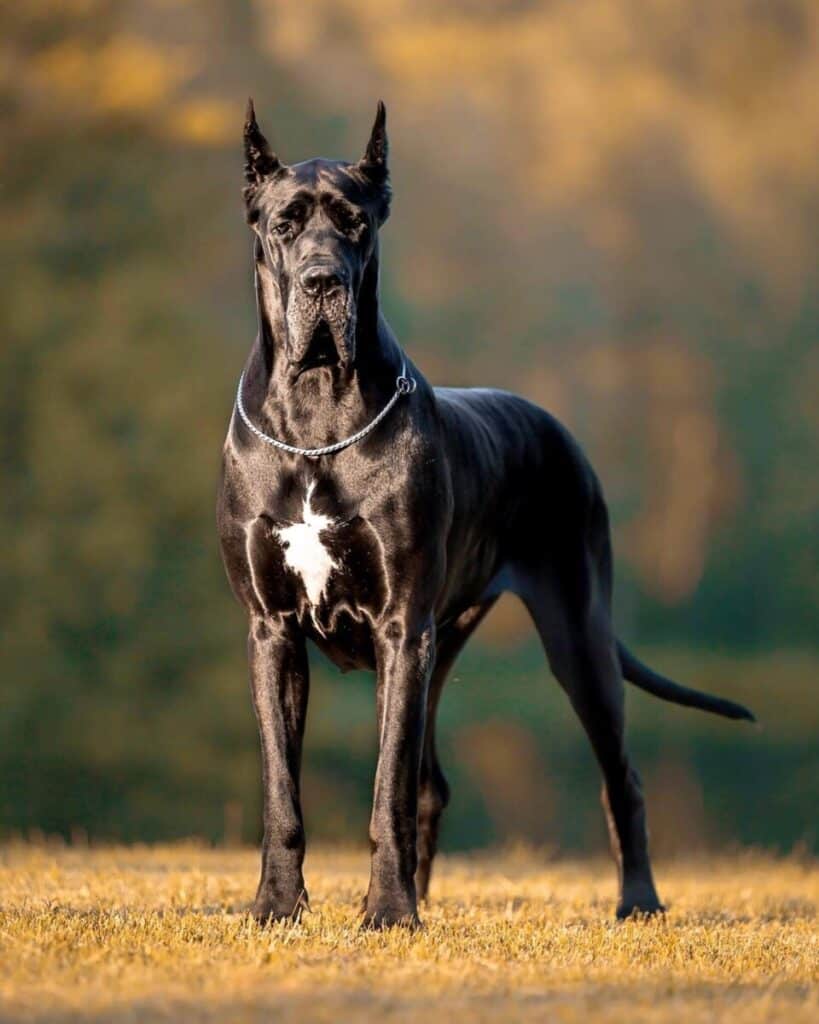



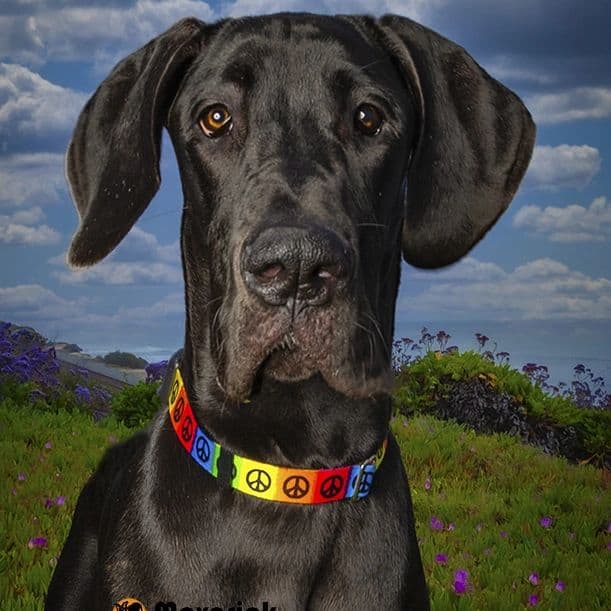

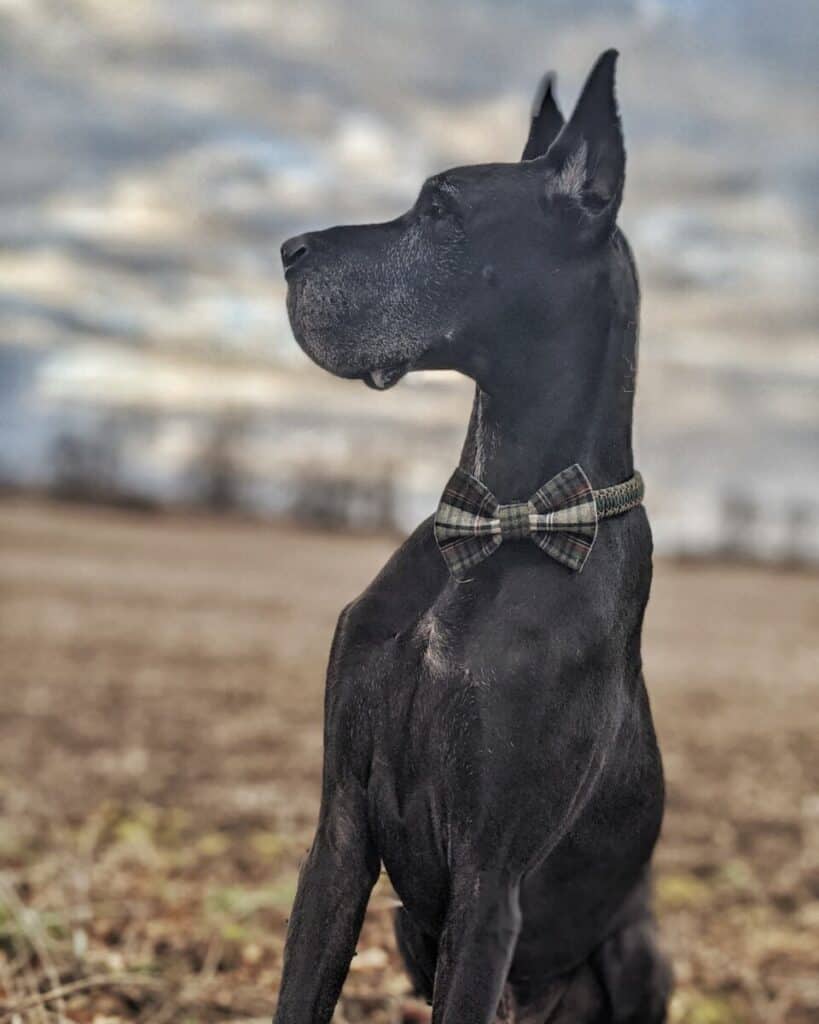
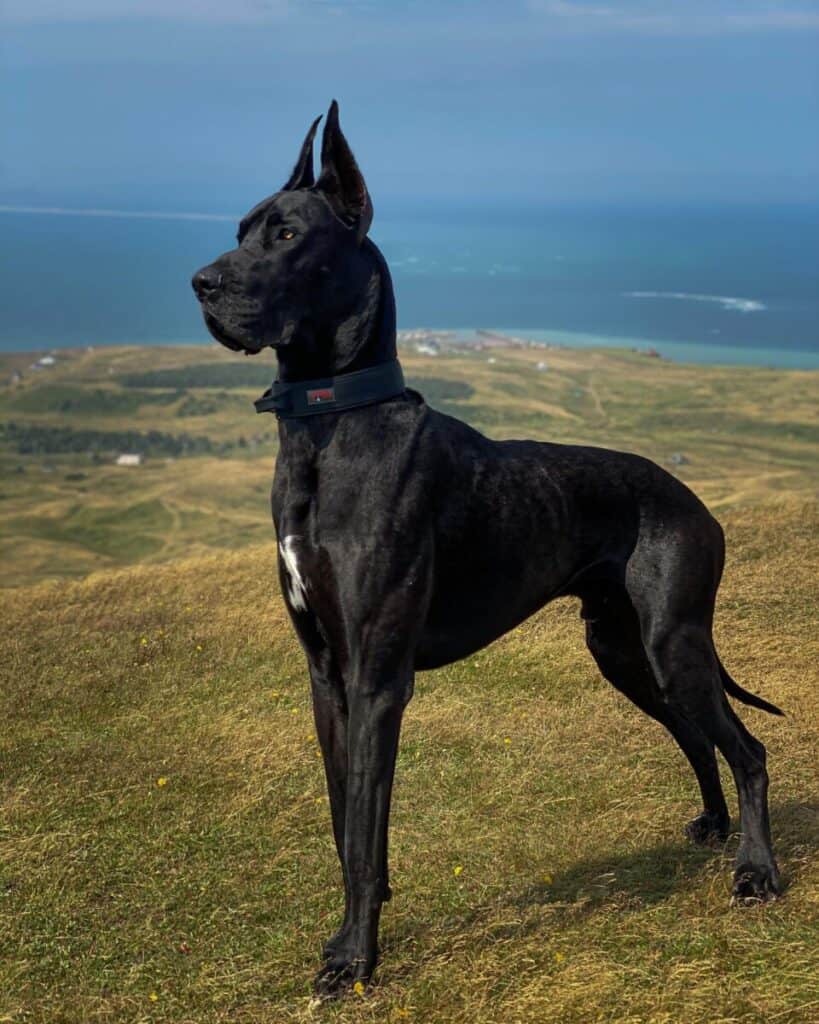

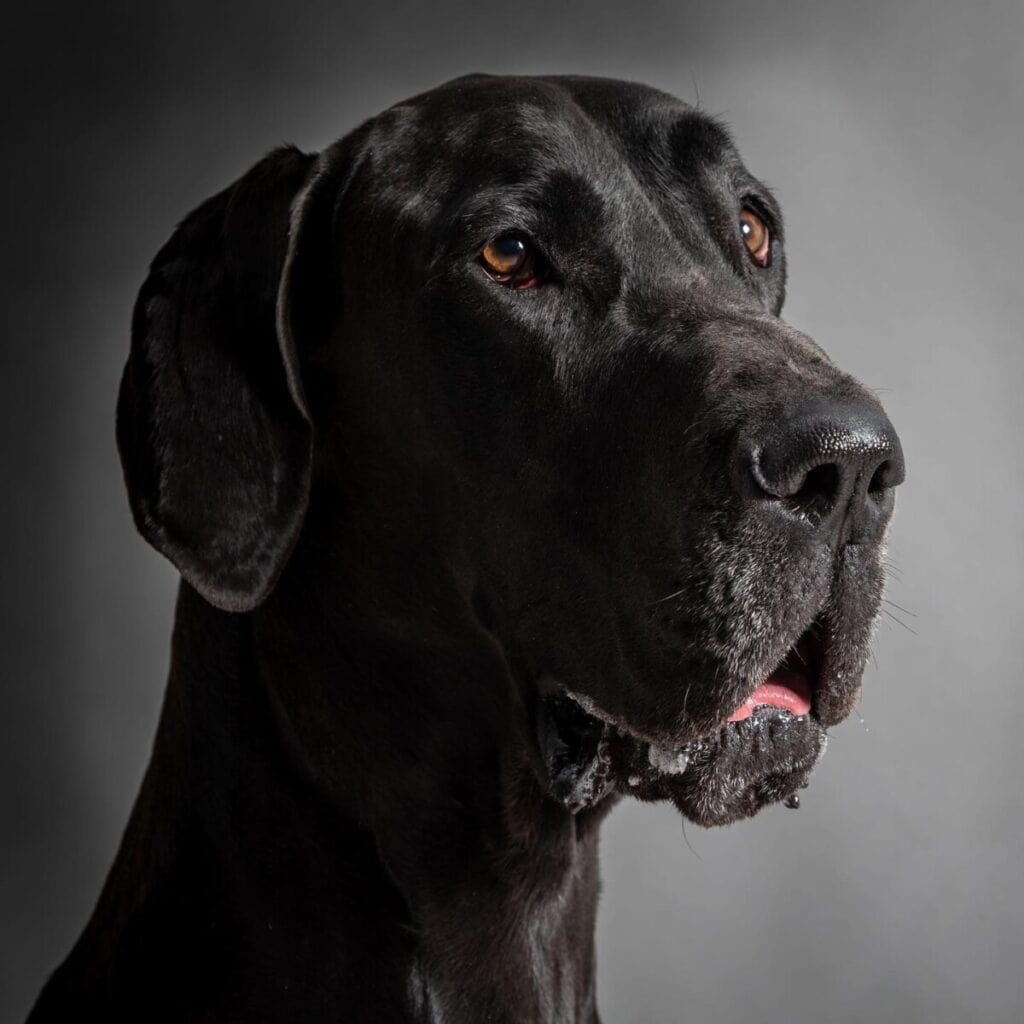


As you can see from the example photos, the white markings around the chest and paws can greatly vary from black coat to coat.
Note: If you are the original image creator and would like your photo removed from this gallery, please send us a message here.
Black Coat Considerations
The most important consideration for black Great Danes is their ability to overheat faster than lighter coat colors. While you should be careful with all dogs in hot conditions, it is especially important for Danes with black coats!
Their darker coat coloring attracts and absorbs light more quickly than lighter colors, and can lead to them overheating faster.
Be very careful when playing or training in direct sunlight or when the outside temperature is above eighty (80) degrees Fahrenheit.
Make sure to take breaks from the exercise, provide them with fresh cool drinking water, and give them a place to cool off out of direct sunlight.
Do NOT leave this dog breed unattended outdoors for long periods when the temperature is elevated.
Aside from this risk of overheating, black Danes do not have any extra health considerations to account for as might be seen with white Great Danes.
How Much Do Black Great Danes Cost?
The cost of a purebred black Dane falls in line with other colors and is typically in the range of $1,700 – $3,000. Dogs from champion lines that are sold as show dogs will be on the higher end of that range and potentially more.
Generally speaking, producing a black Dane is actually easy from a breeding standpoint. Because the gene for a black coat is dominant at the K locus, it is able to override the production of other colors in many cases.
For example, breeding a fawn and mantle would produce a litter of black puppies!
Now while these initial offspring are all black, some will be carriers of the sable and mantle genes, which means that their offspring could theoretically have these colors if bred accordingly.
While coat color genetics can get very complex, I bring these details up to showcase the ease with which a black coat can be produced.
So if a breeder is trying to charge you a premium simply because the puppy is black – they better have a good reason for it aside from just the coat color!
Based on color alone, if the breeder does have different prices per color I would expect black to be on the low end of their pricing.
What Is The Most Expensive Great Dane Color?
Harlequins are generally the most expensive breed color due to the difficulty in safely producing them from a breeding standpoint.
Higher demand for the breed color due to its increasing popularity of the coat has further led to increased costs.
What Are “Black” Great Dane Dogs Called?
Black Great Danes do not have a special name and are simply referred to as “black Great Danes”.
If you’re looking for a name to give your dog, make sure to take a look at my list of Great Dane names here. It has over 261 names that are broken out by color, gender, and more!
General Great Dane Dog Breed Info
Now that we’ve covered a lot of information specific to a black Dane, let’s take a look at some general info about the breed.
Size and Weight
This is a giant breed of dog that stands between 28 and 32 inches tall at the shoulder and can weigh between 110 and 175 pounds.
Males are typically larger than females, but the exact size and weight of the dog can vary depending on factors such as genetics, diet, and exercise.
Coat and Markings
The black Great Dane has a short, thick, and shiny coat that is easy to maintain.
However, black Great Danes can have white markings on their chest, toes, and tail tips. These markings are known as “mantle” markings.
Breed Color Variations
Although the black Great Dane is a solid black color, there are other color variations of the dog breed.
These variations include blue, fawn, harlequin, and brindle.
Blue Great Danes have a grayish-blue coat, fawn Danes have a light brown coat, harlequin Danes have a white base coat with irregular black spots, and brindle Danes have a brown coat with black stripes.
While there are other color variations of the dog breed, the black Great Dane is a striking and unique dog that is sure to turn heads!
Temperament and Personality
These dogs are known for their gentle and affectionate nature, making them excellent family pets.
They are often referred to as gentle giants due to their impressive size and calm temperament. These dogs are loyal companions who enjoy spending time with their owners and are known for their nobility and gentleness.
Despite their large size, the breed is generally well-behaved and obedient. They are intelligent dogs that require mental stimulation to keep them happy and healthy.
Owners should provide plenty of opportunities for exercise and playtime to keep their Great Dane mentally and physically stimulated.
While Danes are known for their loyalty and companionship, they can also be independent at times. They require a firm and consistent hand during training to ensure that they are well-behaved and obedient.
Owners should establish themselves as the pack leader early on to prevent any behavioral issues from arising.
Overall, the personality of a black Dane dog is gentle, loyal, and intelligent. They make excellent family pets for those who are willing to provide them with plenty of love, attention, and mental stimulation.
With proper training and socialization, these dogs can be a joy to be around and a loyal companion for life.
Training and Socialization
Training and socialization are both crucial for all dog’s well-being!
These dogs are intelligent and eager to please, making them relatively easy to train with positive reinforcement training techniques.
When it comes to training, consistency is key for this dog breed.
Most Black Danes respond well to positive reinforcement, such as treats and praise, rather than punishment.
Obedience training is also important for these dogs, as they can be quite strong and may unintentionally knock over people or objects.
Socialization is equally important for these dogs. Early socialization can help prevent shyness or aggression towards other dogs and people.
It is recommended to introduce a puppy to as many different people, animals, and environments as possible to help them develop confidence and good social skills.
Proper socialization should include introducing them to a variety of experiences, such as car rides, trips to the veterinarian, and exposure to loud noises.
It is also important to teach them to walk on a leash and to interact appropriately with other dogs.
Health and Care
Danes are generally healthy dogs, but like all breeds, they are prone to certain health issues.
Proper care and attention can help prevent and manage these issues, ensuring that your black Great Dane lives a long and healthy life.
Some of the most common health issues that the breed faces include hip dysplasia, bloat, heart disease, and wobbler disease.
Hip dysplasia is a genetic condition that affects the hip joint, causing pain and discomfort. Bloat, also known as gastric torsion, is a life-threatening condition that occurs when the stomach twists and fills with gas.
Heart disease can lead to heart failure and other complications, while wobbler disease affects the spinal cord and can cause weakness and paralysis.
Nutrition and Diet
Proper nutrition is essential for maintaining your black Great Dane’s health.
It’s important to choose a high-quality dog food that is specifically formulated for large breeds.
Exercise and Energy
This breed is generally a low to moderate-energy dog that requires exercise to stay healthy and happy.
Regular walks and playtime can help keep your black Great Dane fit and active.
However, it’s important to avoid over-exercising your Great Dane, as this can put a strain on their joints and lead to health problems.
Grooming and Care
Proper grooming and care are essential for keeping your black Great Dane dog healthy and happy.
Regular brushing can help prevent skin issues and keep their coat looking shiny and healthy, as well as help with Great Dane shedding.
It’s also important to schedule regular vet visits to monitor your dog’s health and catch any potential issues early on.
Great Dane FAQs
WHAT IS THE AVERAGE WEIGHT OF A GREAT DANE?
Great Danes are known for their large size and weight. On average, a male can weigh between 120 to 200 pounds, while a female can weigh between 100 to 130 pounds.
However, it is important to note that individual dogs may vary in weight depending on factors such as genetics, diet, and exercise.
WHAT ARE THE DIFFERENT COLORS OF GREAT DANES?
Great Danes come in a variety of colors, including black, blue, fawn, brindle, harlequin, and mantle.
Black is one of the most popular colors and is characterized by a shiny, solid black coat. Some dogs may have small white markings on their chest or toes.
HOW LARGE DO GREAT DANES TYPICALLY GET?
Great Danes are one of the largest dog breeds and can grow to be quite tall. On average, a boy can stand up to 32 inches tall at the shoulder, while a girl can reach up to 30 inches.
Great Danes can weigh up to 175 pounds, making them quite heavy as well. It is important to note that these dogs grow quickly and may reach their full size by the time they are 2 years old.
can a giant breed participate in dog sports?
Yes, giant breeds can indeed participate in dog sports.
While their size may present some unique challenges, such as the need for specialized training and accommodations, many giant breed dogs excel in various activities including obedience, agility, tracking, and even some specialized sports like weight pulling.
With proper training, care, and attention to their specific needs, giant breeds can participate and thrive in dog sports just like any other breed.
Related Posts
If you found this article helpful, make sure to take a look at my other related posts linked below!
